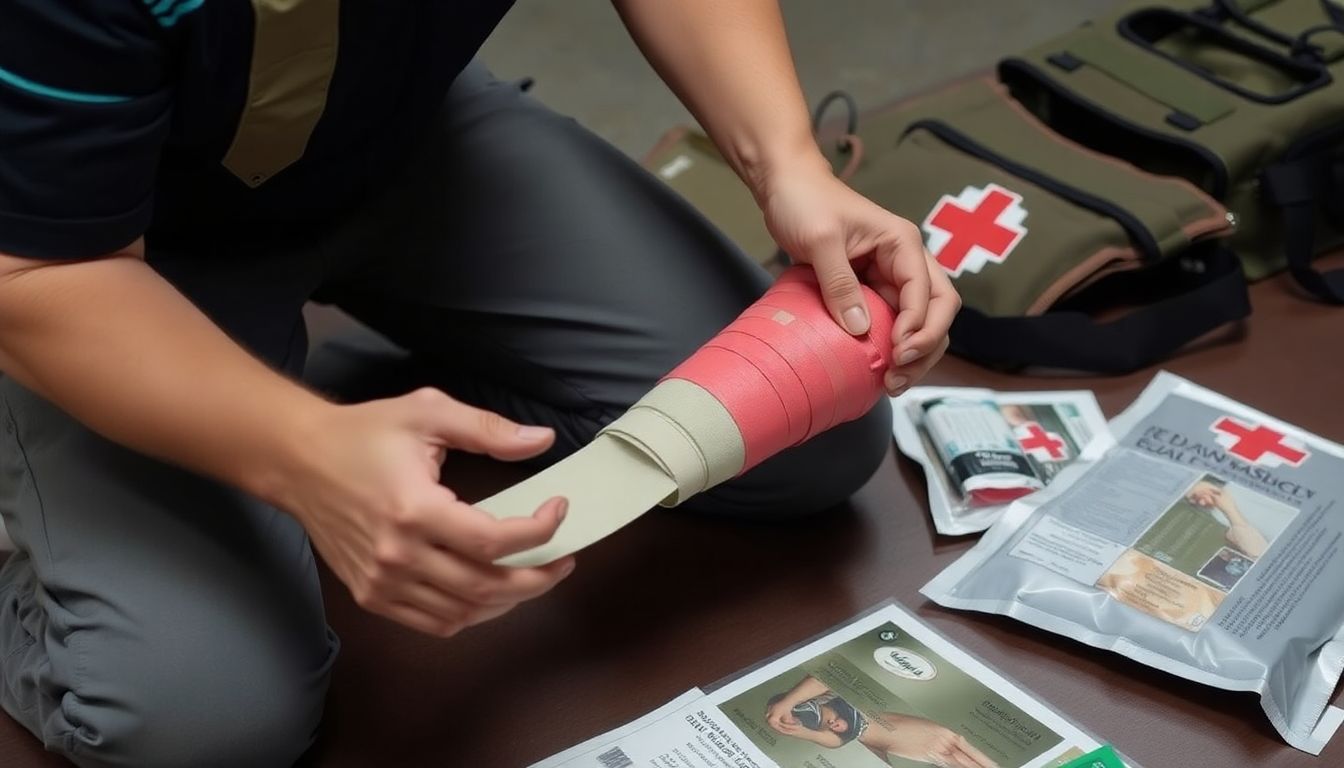Have you ever stopped to think about the sheer number of medical emergencies that could potentially occur in your daily life, let alone in a survival situation? According to the World Health Organization, over 33 million people worldwide require medical attention each year due to injuries alone. Now, imagine if the nearest hospital or medical professional was miles away, or worse, unavailable. This is where medical preparedness comes into play, and it all starts with having the right first aid kit and knowing how to use it. Welcome to ‘The Prepper’s Medical Kit: Essential Supplies and Skills’, your comprehensive guide to survival medicine and ensuring you’re never caught off guard by a medical emergency.
First, let’s address the elephant in the room: why is it so important to be medically prepared? The answer is simple
- it could save your life, or the life of someone you love. A well-stocked first aid kit and the knowledge to use its contents effectively can mean the difference between a minor inconvenience and a major catastrophe. But here’s the thing: most people don’t know what should be in a comprehensive first aid kit, let alone how to use its contents. That’s where this article comes in.
In this article, we’re going to delve into the fascinating world of survival medicine. We’ll start by discussing the importance of medical preparedness and the role a well-stocked first aid kit plays in it. Then, we’ll dive into the nitty-gritty, exploring the essential supplies every prepper needs in their medical kit. But we won’t just stop at what to include
- we’ll also discuss how to use these supplies effectively, turning you into a medical prepper extraordinaire. So, buckle up, because by the end of this article, you’ll not only have a comprehensive understanding of what makes a great first aid kit, but you’ll also have the skills to use it, ensuring you’re always ready for whatever life throws your way.
Mastering Survival Medicine and First Aid Kit Essentials
Embarking on a journey to master survival medicine and first aid kit essentials is akin to becoming a modern-day Swiss Army knife
- versatile, reliable, and ready for any situation. Imagine yourself as the calm in the storm, the beacon of hope in the wilderness, or the lifeline in an urban emergency. This pursuit is not just about acquiring knowledge, but also about cultivating a mindset that turns potential crises into opportunities for action and healing. Picture this: you’re hiking in the backcountry, miles from the nearest town, when a fellow hiker twists their ankle. With your survival medicine know-how, you can assess the injury, stabilize it, and even provide pain relief using your well-stocked first aid kit. Or perhaps you’re at a family gathering when someone suddenly chokes on their food. Your quick thinking and first aid skills could mean the difference between a scary moment and a tragedy averted. Mastering survival medicine and first aid kit essentials is not about seeking out danger, but about being prepared for it. It’s about turning fear into confidence, uncertainty into certainty, and helplessness into empowerment. So, let’s dive in, shall we? The wilderness, the city, and every place in between will thank you.

Understanding Medical Preparedness
Medical preparedness, often overlooked in our daily lives, is a critical aspect of survival situations. Unlike everyday first aid, which focuses on immediate, minor injuries, medical preparedness is about anticipating and mitigating potential health crises in environments where professional medical help might be delayed or unavailable. It’s the difference between having a band-aid for a cut and being equipped to handle a broken bone or a severe allergic reaction in a remote location.
The importance of medical preparedness lies in its role as a lifeline in emergencies. It’s about being proactive rather than reactive, ensuring that you have the tools and knowledge to provide care when it’s needed most. Whether you’re an avid hiker, a parent, or a prepper, understanding and practicing medical preparedness can mean the difference between a minor inconvenience and a life-threatening situation.
A comprehensive medical kit is the backbone of medical preparedness. It should include items like bandages, antiseptics, pain relievers, allergy medication, and even basic medical equipment like a thermometer or tweezers. But having a well-stocked kit is only half the battle. The skills to use it effectively are equally important.
Knowing how to assess a situation, prioritize treatments, and administer first aid is crucial. This includes understanding basic anatomy, recognizing signs of shock, and knowing how to treat wounds, fractures, and burns. It also involves knowing when to seek professional help and how to provide care until it arrives. These skills can be learned through first aid and wilderness first responder courses, which are invaluable for anyone interested in medical preparedness.
In essence, medical preparedness is about being ready for the unexpected. It’s about having the tools and knowledge to provide care when it’s needed most, and the confidence to act decisively in high-pressure situations. It’s not just about surviving; it’s about thriving in the face of adversity.

Assembling Your Base Kit
Assembling your first aid kit is a crucial step in preparing for minor injuries and unexpected situations. A well-stocked kit should be easily accessible and contain a variety of supplies to address a range of common ailments and emergencies. Let’s dive into the essential components of a comprehensive first aid kit, categorized for easy understanding.
Bandages and Wound Care
- Adhesive Bandages (Assorted Sizes): These are essential for covering minor cuts, scrapes, and wounds to prevent infection and keep the area clean.
- Gauze Pads (Assorted Sizes): Larger gauze pads are useful for dressing wounds that are too big for bandages, or for applying pressure to control bleeding.
- Gauze Roll: A roll of gauze can be used to create a makeshift bandage or to secure other dressings in place.
- Medical Tape: This is used to secure dressings and bandages, ensuring they stay in place even during physical activities.
- Antiseptic Wipes or Solution: These help clean wounds and prevent infection. Alcohol wipes or a solution like hydrogen peroxide can be used.
- Antibiotic Ointment: A small tube of an over-the-counter antibiotic ointment, such as Neosporin, can help prevent infection in minor wounds.
Medications
- Pain Relievers (Ibuprofen, Acetaminophen): These can help alleviate minor aches, pains, and reduce fever.
- Allergy Medication (Diphenhydramine): This can help relieve symptoms of allergic reactions, such as itching, sneezing, and hives.
- Antihistamines (Loratadine): These can help prevent or alleviate symptoms of allergic reactions.
- Anti-Diarrheal Medication (Loperamide): This can help manage symptoms of diarrhea, which can be dehydrating and debilitating.
- Prescription Medications: If you or a family member has a chronic condition, include any necessary prescription medications in your kit.
Tools
- Tweezers: These can be used to remove splinters, thorns, or other small objects from the skin.
- Scissors: A pair of small, sharp scissors can be used to cut bandages, gauze, or clothing if necessary.
- Thermometer: A digital thermometer can help monitor fever or other temperature-related issues.
- First Aid Guide or Manual: A comprehensive first aid guide can provide step-by-step instructions for treating various injuries and situations.
Miscellaneous Items
- Latex or Nitrile Gloves: These are crucial for protecting yourself and the victim from cross-contamination and infection.
- Instant Cold Pack: These can help reduce swelling and pain from injuries like sprains or bruises.
- Emergency Blanket: A lightweight, reflective blanket can help prevent shock and maintain body heat in case of exposure to cold temperatures.
- Whistle: A whistle can be used to signal for help in emergency situations.
- Flashlight or Headlamp: A light source can be invaluable in low-light or dark situations, helping you see and be seen.
Each of these items plays a unique role in treating minor injuries and managing unexpected situations. Assembling a comprehensive first aid kit ensures that you’re prepared to handle a wide range of scenarios, providing peace of mind and potentially saving lives.

Special Considerations for Your Kit
When it comes to preparing a medical kit, one size certainly does not fit all. Tailoring your kit to specific needs is not just important, it’s crucial for ensuring that you’re equipped to handle a wide range of situations. Let’s delve into some special considerations that might apply to you or your loved ones.
Firstly, if allergies are a concern, your kit should be stocked with epinephrine auto-injectors, antihistamines, and any other medications prescribed by your allergist. For instance, if someone in your group is allergic to bees, ensure you have epinephrine on hand. Additionally, include an allergy action plan, detailing symptoms and emergency contact information.
Chronic conditions require a more in-depth approach. For diabetes, you’ll need a blood glucose monitor, test strips, insulin (if applicable), and a supply of snacks to treat low blood sugar. If you’re caring for someone with asthma, include a rescue inhaler and a spacer, if recommended. For heart conditions, ensure you have nitroglycerin tablets or a nitro spray, and consider learning CPR.
Age is another significant factor. For children, include age-appropriate first aid supplies, such as smaller bandages and a child-sized CPR mask. For the elderly, consider adding hearing aid batteries, a list of current medications, and any assistive devices they use daily. Always remember to check expiration dates and replace items as needed.
Lastly, consider any unique situations. If you’re planning a trip to a remote area, include extra supplies for treating wounds and managing minor illnesses. If you’re going hiking, pack a whistle for signaling for help. Always research the specific environment you’ll be in and adjust your kit accordingly.
In conclusion, a well-tailored medical kit is a testament to your preparedness and care. It’s not just about having the right supplies, but also about understanding the unique needs of each individual. So, take the time to consider these special considerations, and you’ll be ready to face whatever comes your way.

Understanding and Treating Common Injuries
Injuries are an inevitable part of life, and understanding how to recognize, assess, and treat common ones can make a significant difference in recovery and overall health. Let’s delve into four common injuries: cuts, burns, fractures, and sprains.
Cuts: These are among the most common injuries, often caused by sharp objects. To treat:
- Control bleeding by applying direct pressure using a clean cloth or bandage.
- Clean the cut with soap and warm water to prevent infection.
- Apply an antibiotic ointment and cover with a sterile bandage.
- If the cut is deep, long, or bleeding heavily, seek immediate medical attention.
Remember, cuts on the face, neck, hands, or genitals may require professional medical care.
Burns: Burns are classified by degree, with first-degree being mildest and third-degree being most severe. To treat:
- Cool the burn with cool (not cold) water for 10-15 minutes.
- Protect the burn from further damage with a sterile, non-adhesive bandage or clean cloth.
- Do not apply ice, butter, or any grease to the burn.
- Seek medical attention for second-degree burns or any burn that covers a large area of the body.
Always prioritize safety when treating burns, as they can be very painful.
Fractures: Fractures occur when a bone breaks, often due to trauma. To assess and treat:
- Check for deformity, swelling, and pain.
- Immobilize the injured area using a splint, sling, or other supportive device.
- Apply an ice pack to reduce swelling.
- Seek immediate medical attention, as fractures require professional care.
Remember, some fractures may not be visible on the surface, so trust your instincts if you suspect a break.
Sprains: Sprains occur when ligaments are stretched beyond their normal range, often due to falls or twists. To treat:
- Follow the RICE method: Rest, Ice, Compression, and Elevation.
- Rest the injured area, using crutches if necessary.
- Apply an ice pack for 15-20 minutes, 3-4 times a day.
- Compress the area with an elastic bandage, wrapping from the toes to the knee for ankle sprains, or from the fingers to the shoulder for wrist sprains.
- Elevate the injured area to reduce swelling.
If pain is severe or the joint is extremely swollen, seek medical attention.
Always remember, prevention is the best cure. Be cautious, wear appropriate protective gear, and stay aware of your surroundings to minimize the risk of injuries. If you’re ever unsure about an injury, it’s always best to err on the side of caution and seek professional medical advice.

Managing Illness and Infection
Managing illness and infection is a critical aspect of survival, especially in situations where access to medical professionals is limited. The first step in this process is identification. Common illnesses and infections can manifest in various ways, from fever and cough to skin rashes and abdominal pain. It’s essential to familiarize oneself with these symptoms and monitor one’s health regularly. If symptoms persist or worsen, it’s crucial to seek medical attention if possible.
The treatment of illnesses and infections depends on the type and severity of the condition. For minor ailments like cuts and scrapes, cleaning the wound thoroughly with soap and water, applying an antiseptic, and covering it with a sterile bandage can prevent infection. For more severe conditions, having a basic first aid kit with essential medications like pain relievers, antibiotics, and anti-inflammatory drugs can be lifesaving. However, it’s important to note that self-medication should be done with extreme caution, as incorrect use of drugs can lead to adverse reactions.
Prevention is always better than cure, and this is especially true in survival situations. Maintaining good hygiene and sanitation practices is key to preventing illnesses and infections. This includes regular hand washing, cooking food thoroughly, and avoiding contact with bodily fluids. Proper disposal of medical waste is also crucial to prevent the spread of infection. Used bandages, syringes, and other medical waste should be disposed of in a sealed, puncture-resistant container and buried or burned if no other disposal method is available.
In conclusion, managing illness and infection in survival situations requires a combination of knowledge, preparation, and careful attention to hygiene and sanitation. By understanding how to identify, treat, and prevent common illnesses and infections, one can significantly improve their chances of survival in challenging environments.

Mastering Survival Medicine Skills
Mastering survival medicine skills is not just about knowing what to do, but also about being prepared and confident in high-pressure situations. Let’s delve into three essential skills: Cardiopulmonary Resuscitation (CPR), wound cleaning, and splinting.
CPR: The Breath of Life CPR is a critical skill that can mean the difference between life and death. Here’s a step-by-step guide:
- Check the environment and the person. Make sure the scene is safe before approaching the person.
- Kneel beside the person and open the airway using the head-tilt chin-lift maneuver.
- Look, listen, and feel for breathing. If there’s no breathing, begin chest compressions.
- Push hard and fast in the center of the chest, allowing the chest to recoil completely between compressions. Aim for a depth of at least 2 inches (5 centimeters) for adults.
- After 30 compressions, open the airway using head-tilt chin-lift and give two rescue breaths.
- Continue cycles of 30 compressions and 2 breaths until the person begins to move, emergency services arrive, or an Automated External Defibrillator (AED) becomes available.
To practice, consider taking a certified CPR course. You can also use CPR mannequins and online resources to hone your skills.
Wound Cleaning: The Key to Infection Prevention Cleaning wounds properly is crucial to prevent infection. Here’s how:
- Wash your hands thoroughly with soap and water before and after cleaning the wound.
- Clean the wound with clean water or a saline solution. Avoid using hydrogen peroxide or iodine, as they can harm cells and delay healing.
- Use clean gauze or a clean cloth to gently clean the wound from the bottom up and from one side to the other.
- Apply a thin layer of antibiotic ointment to the wound to keep it moist and prevent infection.
- Cover the wound with a sterile bandage or dressing.
To teach others, demonstrate the steps clearly and encourage them to practice on a mock wound.
Splinting: Providing Support and Stability Splinting can help prevent further injury and provide support to broken bones. Here’s how to create a simple splint:
- Use a rigid material like a stick, a piece of wood, or a commercial splint.
- Position the splint along the length of the injured limb, ensuring it doesn’t rest on any wounds.
- Secure the splint with bandages, strips of cloth, or tape. Make sure it’s snug but not too tight.
- Immobilize the joint above and below the injury to provide additional support.
To practice, use a willing partner and a mock injury. Always remember, splinting is not a substitute for professional medical care.
Always keep your skills sharp and stay updated with the latest guidelines. Happy learning!

Building a Relationship with Your Medical Kit
Building a relationship with your medical kit is not just about having it ready when you need it, but also about understanding and being familiar with its contents. This familiarity can mean the difference between a minor inconvenience and a major crisis. Imagine, for instance, needing to administer a specific medication in an emergency, but you’re fumbling through your kit because you’re not sure where anything is. That’s why it’s crucial to organize your medical kit in a way that makes sense to you and is easy to navigate.
Start by categorizing your items. Keep bandages and dressings together, medications in a separate section, and tools like tweezers and scissors in their own compartment. Use clear plastic bags or containers to keep things visible and prevent them from shifting around. Labeling can also be helpful, especially for items that look similar but have different uses.
Maintaining your medical kit is just as important as organizing it. Check your kit regularly to ensure nothing has expired or been used up. Make a habit of replacing items after each use, or at least once a year, depending on how often you use your kit. It’s also a good idea to keep a list of what’s in your kit and where it’s located, so you can quickly see what needs to be restocked.
Updating your kit is also crucial. As your health needs change, so should your medical kit. If you develop a new allergy, add the appropriate medication. If you start a new medication, make sure to include it. If you gain or lose a family member, adjust the quantity of items accordingly.
Finally, teaching others in your group how to use your medical kit effectively is not just a good idea, it’s a necessity. You never know when you might need someone else to step in and administer first aid. Start by explaining the organization of your kit. Then, walk them through each item, explaining what it’s for and how to use it. Finally, practice using the kit together. This will not only help them become familiar with the kit, but it will also help you reinforce your own knowledge. After all, the best way to learn is to teach.

Advanced Medical Supplies and Skills
In the realm of advanced first aid, several specialized tools and techniques can significantly enhance your ability to provide critical care in emergency situations. Let’s delve into three such advancements: tourniquets, chest seals, and wound packing.
Tourniquets are invaluable when dealing with severe limb bleeding. They work by compressing the blood vessels, stopping blood flow to the injured area. To use a tourniquet, follow these steps:
- Remove any clothing or debris from the wound.
- Place the tourniquet 2-3 inches above the wound, on the side of the heart.
- Wrap the tourniquet around the limb, ensuring it’s tight enough to stop blood flow.
- Secure the tourniquet in place, and note the time it was applied.
Remember, tourniquets should only be used when bleeding is life-threatening, and you must seek immediate medical attention.
Chest seals are designed to manage open pneumothorax, a life-threatening condition where air enters the chest cavity through a wound. To apply a chest seal:
- Clean the area around the wound.
- Remove the backing from the chest seal.
- Place the seal over the wound, ensuring it covers the entire opening.
- Press firmly to create a tight seal, and secure it in place.
Wound packing is a technique used to control bleeding from deep or irregular wounds. Here’s how to pack a wound:
- Clean the wound and remove any debris.
- Tear gauze into strips, or use pre-packaged gauze strips.
- Insert the gauze into the wound, packing it tightly but gently.
- Apply pressure to the wound with a bandage or dressing.
Always remember, these advanced techniques should be used when you’ve received proper training. They can significantly improve outcomes in emergency situations, but they must be employed with care and knowledge.

Creating a Medical Plan for Your Group
Creating a medical plan for your group or family is not just a smart idea, it’s a necessity that can make all the difference in times of crisis. A well-thought-out medical plan ensures that everyone’s health and safety are prioritized, and that everyone knows their role in maintaining that safety. Let’s break down the key components of such a plan.
First and foremost, designate a medical point person. This could be the most medically knowledgeable person in your group, or someone who is calm under pressure and can make decisions quickly. Their role is to coordinate medical care, ensure everyone’s needs are met, and communicate with external medical services if necessary. They should have a list of everyone’s medical conditions, allergies, and current medications.
Next, establish a medical cache. This is a supply of medical equipment, medications, and first aid supplies that can be used in case of an emergency. The contents of your cache will depend on the specific needs of your group, but it should include items like bandages, antiseptic wipes, pain relievers, and any prescription medications that are regularly taken by members of your group.
Lastly, planning for long-term care needs is crucial. This includes not just immediate medical needs, but also planning for chronic conditions, disabilities, and end-of-life care. It’s important to have conversations about these topics now, while everyone is healthy and calm, rather than waiting until a crisis occurs. This could involve setting up power of attorney, creating living wills, or planning for long-term care facilities.
In essence, creating a medical plan for your group is about being proactive, not reactive. It’s about ensuring that everyone’s health and well-being are taken care of, no matter what situation arises. So, let’s not wait for a crisis to happen. Let’s start planning today.

Continuing Education and Resources
FAQ
What is the difference between a basic first aid kit and a prepper’s medical kit?
What are some essential supplies to include in a prepper’s medical kit?
- Wound care: Bandages, gauze, adhesive tape, antiseptic wipes, and dressings.
- Medications: Pain relievers, antibiotics, antihistamines, and any prescription medications you or your family might need.
- Medical tools: Tweezers, scissors, thermometer, and a first aid manual.
- Safety equipment: Latex gloves, face masks, and eye protection.
- Specialty items: Splints, tourniquets, and a CPR mask.
- Hygiene and sanitation: Hand sanitizer, soap, and disposable toothbrushes.
How do I choose the right medical kit for my needs?
- Your medical knowledge and skills.
- The age and health of your group.
- The potential hazards and disasters in your area.
- Whether you’ll be staying at home or bugging out.
- Your budget.
It’s also a good idea to consult with a healthcare professional when building your kit.
What medical skills are essential for medical preparedness?
- CPR and basic life support.
- Wound cleaning and dressing.
- Splinting and immobilizing injuries.
- Recognizing and treating shock.
- Administering medications, including epinephrine for severe allergic reactions.
- Identifying and treating common medical conditions like dehydration, heat exhaustion, and hypothermia.
Consider taking a first aid and CPR course to learn and refresh these skills.
How often should I update my prepper’s medical kit?
- Check your kit every 6 months for any signs of damage or wear and tear.
- Replace any expired medications and supplies annually.
- Review and update your kit after any significant changes in your family’s health or medical needs.
- After each use, restock and replace any used items.
Also, consider rotating your supplies to ensure you’re using and replacing items regularly.
What should I do if I run out of a critical medication or supply during an emergency?
- Check your other medical kits or supplies to see if you have any extra or similar items.
- Contact other preppers or your local emergency response team to see if they have any to spare.
- If it’s safe to do so, try to find a pharmacy or medical supply store that might have what you need.
- If it’s a life-threatening situation, you may need to seek immediate medical attention.
- In all cases, document what you’ve used and what you need to replace to ensure you’re fully stocked again as soon as possible.
How can I prepare my family for medical emergencies?
- Educate your family on basic first aid and medical skills. Consider taking a family first aid course together.
- Create a family emergency plan that includes medical needs and responsibilities.
- Establish a family communication plan in case you get separated.
- Keep important medical documents, like insurance cards, immunization records, and a list of medications, in a secure and accessible location.
- Practice drills to prepare for different scenarios and ensure everyone knows what to do.
- Consider learning about herbal and alternative medicines that could supplement your medical kit in a pinch.









